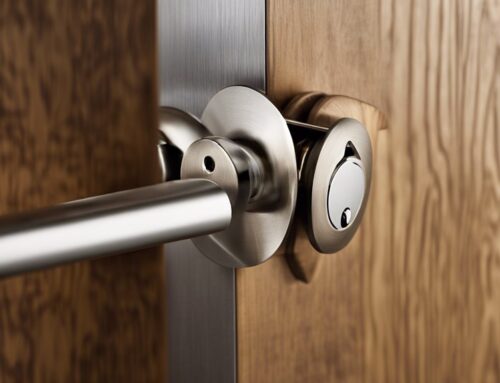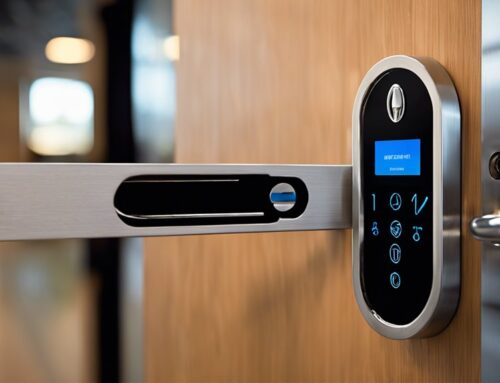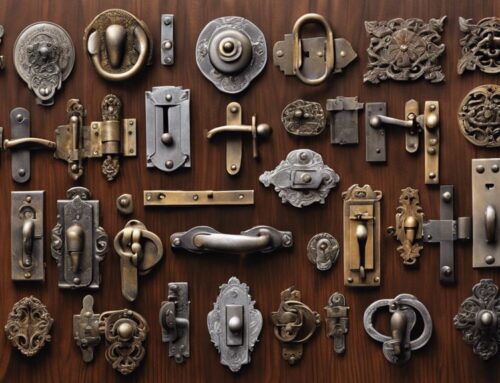Lock and key, a timeless duo that has safeguarded treasures and secrets for centuries. From the ancient civilizations of Assyria and Egypt to the intricate designs of the Gothic period, the evolution of locks and keys has been nothing short of remarkable.
Today, in the age of technology and innovation, these humble devices have become even more complex and sophisticated, ensuring our safety and security.
Join us on a journey through the fascinating history, anatomy, and world of locksmithing, where the art of protection finds its rightful place.
The History of Locks and Keys
Locks and keys have been used for thousands of years. Early examples were discovered in the ruins of Nineveh, and the Romans invented metal locks and keys. The development of lock picking techniques has been intertwined with the creation of famous historical locks and keys throughout history. One notable example is the Egyptian wooden pin lock, which consisted of a bolt, door fixture, and key. The Romans introduced metal locks and keys, along with the system of security provided by wards. Affluent Romans even wore their keys as rings. Gothic locks, known as ‘drunk man’s locks,’ were designed with decorative foliage and a keyhole that could be found in the dark.
Today, lock picking techniques continue to evolve. However, the rich history of locks and keys serves as a testament to our desire for security and belonging.
Evolution of Modern Locks
During the Industrial Revolution, locks and keys became increasingly complex and sophisticated with the invention of the lever tumbler lock by Robert Barron in 1778. This marked a significant advancement in lock manufacturing technology, paving the way for modern security systems.
Here are four key points to consider:
- Technological advancements in lock manufacturing: The lever tumbler lock introduced a mechanism that used levers to prevent the lock from opening without the correct key. This innovative design greatly improved security and laid the foundation for future lock developments.
- Impact of modern security systems on the locksmithing industry: As security systems became more advanced, locksmiths had to adapt and expand their skills to meet the demands of the industry. They now deal with complex electronic locks, biometric systems, and other high-tech security solutions.
Today, locksmiths play a crucial role in ensuring the safety and security of individuals and businesses, providing services ranging from lock installation and repair to key duplication and emergency lockout assistance. The locksmithing industry continues to evolve alongside technological advancements, making it an essential component of modern society’s security infrastructure.
Anatomy of a Key
The bit blade of a typical key slides into the keyway of the lock, distinguishing between different keys. This process is essential in the key cutting process and key duplication techniques.
When it comes to duplicating a key, locksmiths use various methods to ensure an accurate copy. One common technique involves using a key cutting machine that traces the original key’s shape and cuts a duplicate key accordingly. Another method is to use a key duplicator, which uses a rotating cutting wheel to create an identical copy of the original key.
Both techniques require precision and expertise to ensure that the duplicate key functions properly. By mastering these key duplication techniques, locksmiths are able to provide their customers with accurate duplicates, ensuring their sense of belonging and security.
Different Lock Materials
Brass, plated brass, nickel silver, and steel are common metals used in the construction of locks. Each of these metals has its own unique properties and advantages when it comes to making locks.
Here is a comparison of the pros and cons of these lock materials:
- Brass: Brass is a popular choice for locks due to its corrosion resistance and durability. It is also aesthetically pleasing, making it a good choice for both functional and decorative locks. However, brass can be more expensive compared to other metals.
- Plated Brass: Plated brass provides the same benefits as brass, but with the added advantage of an attractive appearance. The plating can be made of materials like gold or chrome, enhancing the lock’s visual appeal. However, the plating may wear off over time, reducing the lock’s aesthetic value.
- Nickel Silver: Nickel silver is often used in locks for its decorative purposes. It has a silver-like appearance and can be polished to a high shine. However, it is not as strong as other metals, making it less suitable for high-security locks.
- Steel: Steel is known for its strength and is commonly used in high-security locks. It provides excellent protection against physical attacks and is highly durable. However, steel locks may be more susceptible to rust and corrosion if not properly maintained.
When choosing a lock, it is important to consider the specific needs and requirements, as well as the pros and cons of each lock material.
The World of Locksmithing
Locksmiths are skilled professionals who specialize in the installation and maintenance of locks and key control systems. They have a deep understanding of locksmithing techniques and undergo specific training to acquire the necessary skills.
The training requirements for locksmiths may vary depending on the country, but it often involves completing an apprenticeship or a formal education program. During their training, locksmiths learn various techniques such as lock picking, key cutting, and lock installation. They also acquire knowledge about different types of locks and key systems, including automotive locks, master key systems, and safes.
Locksmiths play a crucial role in ensuring the security of homes, businesses, and vehicles. They can also work as security consultants, providing expert advice on enhancing security measures.
Frequently Asked Questions
How Does a Lock Actually Work to Keep Something Secure?
A lock works by using a mechanism to prevent unauthorized access. Different types of locks, such as pin tumbler locks and combination locks, employ different mechanisms to achieve this.
Pin tumbler locks have a series of pins that align when the correct key is inserted, allowing the lock to be turned and open.
Combination locks, on the other hand, require the correct sequence of numbers or symbols to be inputted in order to unlock them.
Each type of lock has its own unique way of securing something.
What Are Some Common Techniques Used by Locksmiths to Pick Locks?
Locksmiths utilize various techniques and tools to pick locks, allowing them to gain access to locked doors or containers.
Different types of lock picking tools include tension wrenches, lock picks, and key extractors.
Common lock picking techniques involve manipulating the pins inside the lock cylinder using these tools, such as raking, single pin picking, and bumping.
These techniques require skill, knowledge, and precision to successfully manipulate the lock and open it without the original key.
Are There Any Famous or Notable Examples of Locks Being Successfully Picked?
Famous lock pickers have existed throughout history, showcasing impressive skills and knowledge in bypassing security mechanisms. However, the legality of lock picking varies depending on the jurisdiction.
While some countries consider it a criminal offense unless performed by licensed professionals or for legitimate purposes, others allow it as a hobby or educational pursuit.
It is important to respect the laws and regulations regarding lock picking to ensure ethical behavior and avoid potential legal consequences.
Can a Lock Be Completely Unpickable or Is There Always a Way to Bypass It?
Lock bypassing techniques have been a subject of interest and debate among locksmiths and security experts. While it is commonly believed that no lock is completely unpickable, there are locks that are designed to provide a higher level of security and resistance to picking.
Advanced lock picking techniques, such as lock bumping and lock decoding, have been developed to bypass certain types of locks. However, it is important to note that the effectiveness of these techniques can vary depending on the specific lock and the skill level of the individual attempting to bypass it.
What Are Some Common Misconceptions About Locks and Keys That People Have?
Common misconceptions about lock and key security can lead people to underestimate the effectiveness of certain techniques. It’s important to debunk these myths to ensure a better understanding of lockpicking.
One common misconception is that all locks can be easily picked. However, this is not true, as modern locks are designed with complex mechanisms to prevent unauthorized access.






